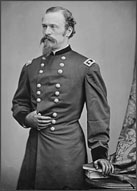 |
State War Records |
| AL - AK - AZ - AR - CA - CO - CT - DE - FL - GA - HI - ID - IL - IN - IA - KS - KY - LA - MA - MD - ME - MI - MN - MS - MO - MT - NE - NV - NH - NJ - NM - NY - NC - ND - OH - OK - OR - PA - RI - SC - SD - TN - TX - UT - VT - VA - WA - WV - WI - WY |
Major General James H. Wilson
 |
| NAME |
| Wilson, James Harrison |
| BORN |
| September 2, 1837 Shawneetown, Illinois |
| DIED |
| February 23, 1925 Wilmington, Delaware |
| ARMY |
| Union |
Wilson graduated from West Point in 1860, ranked 6 out of 41 in his class. He was assigned to the Topographical Engineers and served as the Assistant Topographical Engineer in the Department of the Oregon.
Wilson's ambitions led him to leave the frontier at Fort Vancouver, Washington in order to play a more central role in the Civil War. He spent the first couple of years of the war in engineering and staff positions. He served under Brigadier Gen. T.W. Sherman as Chief Topographical Engineer on the Port Royal Expedition as a 1st lieutenant. He took part at Fort Pulaski. Next, he was a volunteer Aide-de-Camp to Major Gen. George McClellan at South Mountain and Antietam.
Late in 1862, he joined Lieutenant Gen. Ulysses S. Grant's army. His friendship with Grant led to his being promoted to staff Lieutenant Colonel and Inspector General of the Army of the Tennessee. He became the Assistant Engineer and Inspector General, He took part in the Yazoo Pass Expedition and the Vicksburg Campaign, where he was at Port Gibson, Jackson, Champion's Hill, Big Black River, and the Vicksburg siege. After being promoted to Brigadier General after the campaign, he was at Missionary Ridge and Knoxville. At 28 years-old, he was the youngest general in the Union Army.
Grant gave him command of a newly formed Cavalry Bureau in Washington, D.C. He contributed tremendously to their effectiveness by seeing that they were armed with the new Spencer carbines. He took command of the 3rd Division, Cavalry Corps, Army of the Potomac on April 13, and led his troops at Spotsylvania Court House, Sheridan's Richmond Raid battles, Haw's Shop, and in the cavalry operations around Petersburg. After being transferred to the Army of the Shenandoah, he led at Summit Point and Winchester. In June 1864, however, his first independent raid, the Wilson-Kautz Raid almost ended in disaster.
After Wilson took over the Cavalry Corps, he commanded his cavalry that destroyed Lieutenant Gen. John B. Hood's army at Franklin, Nashville, Ebanezer Church, the Wilson's Selma Raid, Montgomery, Columbus, and Macon. The Selma Raid ended in April, when he learned of Gen. Robert E. Lee's surrender at Appomattox Court House. His troops captured President Jefferson Davis on May 10, 1865, at Irwinsville, Georgia. For this, he was promoted to major general on June 21, 1865.
In 1870, Wilson resigned his commission, and began working as a civilian engineer and railroad executive. He returned to the military when the Spanish-American War began, then retired in 1901, with the rank of Brigadier General in the Regular Army. He saw service in China during the time of the Boxer Rebellion in 1901. He was the U.S. representative to Edward VII's coronation in 1902.
Wilson wrote several books and articles about the Civil War and he died at his home in Wilmington, he one of the last surviving Union generals. There were only 3 Civil War generals that lived longer.
Wilson was probably the most distinguished of the "boy generals". He was the only officer promoted to troop command from Grant's regular staff.
Promotions:
- 1st Lieutenant- September 9, 1861
- Lieutenant Colonel - November 8, 1862
- Brigadier General USV- October 30, 1863
- Major General USV- October 5, 1864 (breveted for war service)
- Brigadier General USA- March 13, 1865 (breveted for actions at Fort Pulaski, Chattanooga, Wilderness, and Nashville)
- Major General USA- March 13, 1865 (breveted for Selma Raid)
Major Commands:
- Chief Topographical Engineer/ Port Royal Expedition
- Hunter's staff/ Department of the South (March 15- August 19, 1862)
- Chief Topographical Engineer/ Army of the Tennessee (October 17, 1862- March 3, 1863)
- Assistant Inspector General (November 8, 1862- November 7, 1863)
- Assistant Engineer and Inspector General (March 3- October 31, 1863)
- Cavalry Bureau (February 17- April 7, 1864)
- 3rd Division/ Cavalry Corps/ Army of the Potomac (April 13- September 30, 1864)
- Cavalry Corps/ Military Division of Mississippi (October 29, 1864- June 26, 1866)
